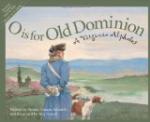And the wind howled and the boat pitched; but Nautica gazed in such relief at the immovable handkerchief that she fell asleep in her chair. When she wakened with a start and looked anxiously at the handkerchief, it was too late—the storm was over.
In the morning there was nothing to show for all that night’s commotion. Smooth, peaceful, and lazy, old Powhatan was loitering in the sunlight to the sea. But Gadabout was not to be soothed into forgetfulness of those night hours. As soon as she had her morning work done up, she hoisted anchor and headed again for her quiet harbour in Herring Creek. After that, when we had a mind to go to Westover, we usually had no mind to take Gadabout with us. Instead, we were more likely to row up the river or to walk up the beach at low tide.
On the occasion of our last visit to the manor-house, we determined to go “beachway.” We ran our rowboat on a sandy point jutting into the mouth of the creek, and took our way along the narrow strip of solid land that lay between river and marsh. White-limbed sycamores and tangled undergrowth went along with us, and sometimes inclined to take up more than their share of the narrow way. Brilliant berries gleamed on some bare, brown bushes, and the green leaves of the smilax pretended that they grew there too. Along the beach, tall bunches of reeds stood out against the brown of the river and the blue of the sky in their waving slenderness.
Looking backward across the marshes, we could see the white railing on Gadabout’s upper deck and could catch the flutter of her flags through the openings in the trees. As we neared Westover, a slope led to higher land and to a riverward, side entrance to the grounds. Passing through this, a tangle of vines swinging with the great iron gate, we followed the walk toward the house.
Just before reaching the ballroom wing, we paused in front of a small brick outbuilding to have a few appropriate shivers over what was under it. From reading and from our talks at Westover, we knew about the mysterious subterranean chambers down there. To be sure, we had not seen them yet (one thing and another having got in the way of our making a visit to them); but surely one need not always wait to see; one can shiver a little anyway upon hearsay.
And the hearsay was like this. Somewhere underneath that brick outbuilding was an opening down into the earth, like a dry well, some fifteen or twenty feet deep. At the bottom, arched doorways on opposite sides of the shaft opened into two small square rooms. The walls of the well and of the rooms were cement; and the floors were paved with brick. A round stone table used to stand in one of the rooms. From this well once ran two passages or tunnels, large enough for people to go through; one connecting with the house by a curious stairway in the old wing that was destroyed in the war, and the other leading to the river.




